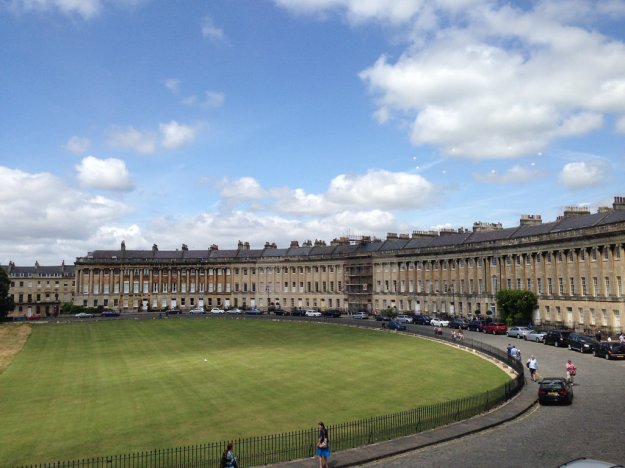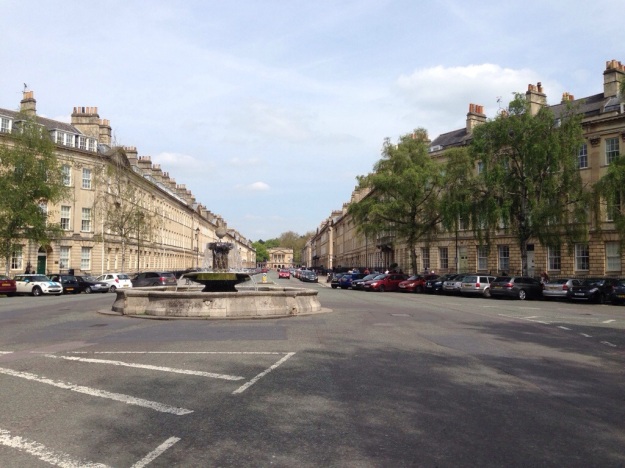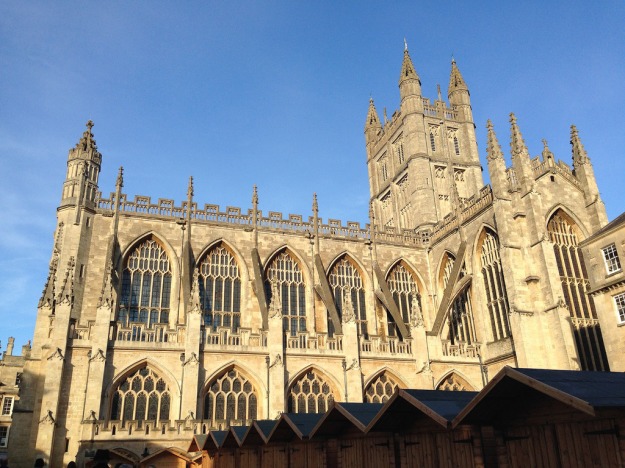Visits: 23rd November 2013, 4th May 2014, 3rd April 2016, 11th July 2015, 2nd July 2016
The City of Bath is really two significant cities, one on top of the other. It is notable as both a Roman town “amongst the most famous and important Roman remains north of the Alps” and as a triumph of Georgian town planning. I lived in Bristol for 4 years from 2012 to 2016, so Bath was my local WHS and I visited it a number of times.
In May 2014 Natalie and I visited specifically to sightsee, so queued up to see the Roman baths for the first time. Bath was known as Aquae Sulis in Roman times, and sits atop a thermal spring that bubbles up 1.2 million litres of water per day at 46°C.
The Romans took full advantage of the town’s endowment, building a spa with all the typical rooms they had back home. On entering the spa, you would get changed in the apodytarium before heading into the tepidarium – a mildly warm room, designed to help you acclimatise – before walking through to the the caldarium – which was heated to something like 50°C. The warmth and moisture was piped through the spa using an underfloor heating system known as a hypocaust.
After a hot bath in the caldarium and perhaps a massage or strigil, the bather might brave the frigidarium and its cold-water pool. I’d been to a bathhouse in Pompeii back in year 7 at school, but forgotten almost everything since then. Seeing it all again in Britain brought back some of the memories I had though, and makes me keen to revisit it (and the better-preserved Herculaneum nearby).
Among the artefacts discovered here in Bath is this fierce-looking carving that stood over the entrance. Archaeologists don’t agree on whom it is meant to depict – with snakes for hair it resembles a gorgon, except for the fact that gorgons were always female, and this face is clearly a man’s. There are connections in Greek mythology between Medusa and Athena (Greek name for the Roman goddess Minerva), which could explain the link, since the site here in Bath appears to have been extensively dedicated to the syncretic Romano-Celtic deity Sulis Minerva. But this is getting too deep into ancient mythology for me to keep up with, so I’ll stop!
In addition to the bathhouse, Bath is famed for its consistent and extensive Georgian architectural style. This was the pet project of three 18th century architects under George III who set out to create in England one of the most beautiful cities in Europe. We crossed the river Avon, where a boat appeared to have taken a wrong turning, and walked up the impressive Great Pulteney Street toward Sydney Gardens.
I’ve been wanting to visit this park for a while, ever since my train once stopped where the line passes through the middle. It was just as tranquil and green as I had hoped it would be.
The city was modelled after the architectural style of 16th century Venetian architect Andrea Palladio, and thus bears a resemblance in some ways to the fellow World Heritage Site of Vicenza, which I look forward to visiting one day. Everyone who visits Bath goes to see the Royal Crescent, which is known as one of the city‘s showstoppers (top photo).
Other things I can recommend are the Holburne gallery (above), Bath Abbey (not quite the cathedral of the Diocese of Bath & Wells – but almost! – below) and the Bath Skyline walk around the fringe of the city.







Pingback: • Historic Centre of Florence | Tom's World Heritage Site travel blog
Pingback: • Assisi, the Basilica of San Francesco and Other Franciscan Sites | Tom's World Heritage Site travel blog
Pingback: • The Great Spa Towns of Europe | Tom Livesey's World Heritage Site blog